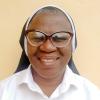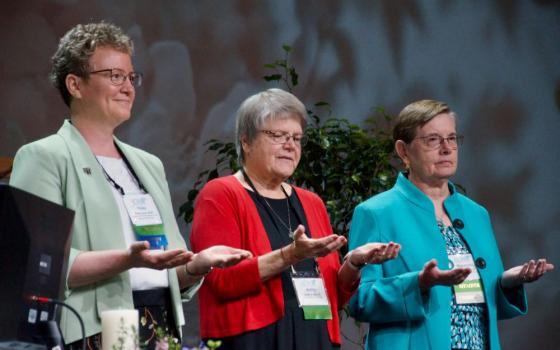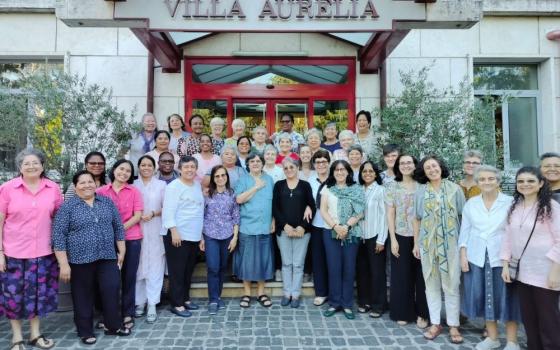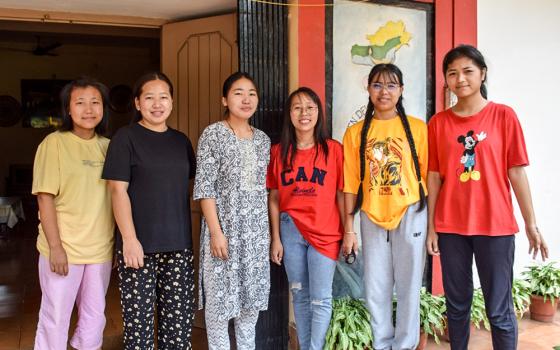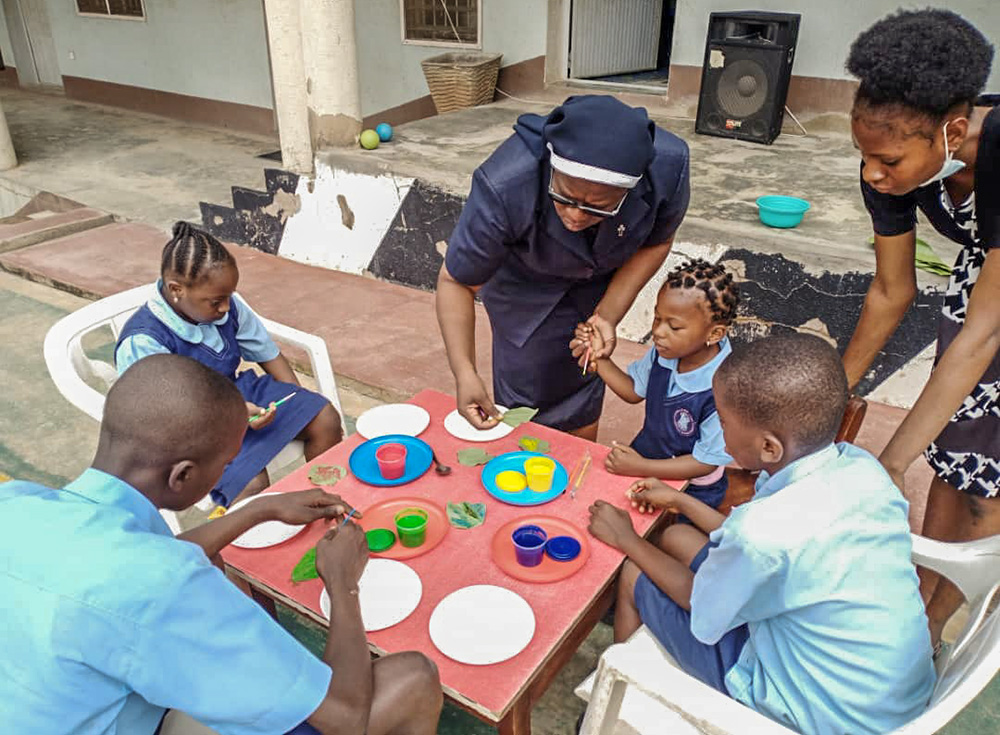
St. Louis Sr. Christie Udebor, center, supports students in a leaf painting activity at the Community Based Rehabilitation Center in Akure, Ondo state, Nigeria. (Courtesy of Christie Udebor)
I have had a passion for education of children with disabilities since I was a postulant. I breathed in this passion from one of my formation directors, and my interest grew. However, it went out of my consciousness as I was assigned to a variety of ministries, but it was reignited when I returned to Ibaden, Nigeria, and found a boy, Mark, with disabilities in my classroom.
At that time, I didn't know exactly how to teach him, so I had to experiment. My dream now is to be educated and licensed for this important ministry.
I recently attended a meeting in Abuja where two foundations that had been funding our Sisters of St. Louis schools for education of children with disabilities informed us that funding would no longer be available. I was devastated, but they did offer us a new way of education called community-based rehabilitation.
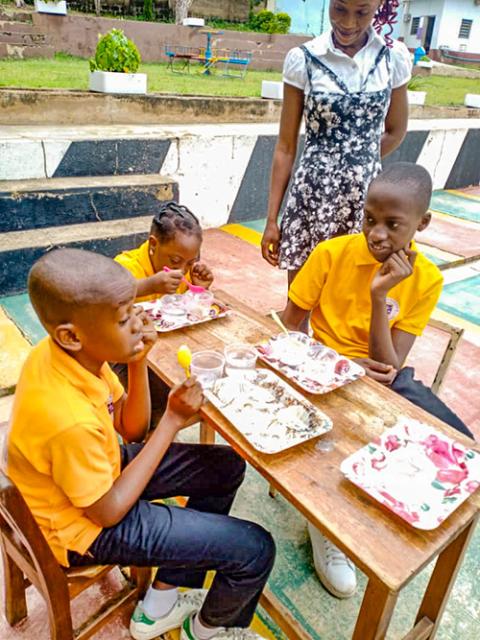
Students learn how to transfer water from one container to another using a spoon at the Community Based Rehabilitation Center in Akure, Ondo state, Nigeria. The exercise helps with hand-eye coordination. (Courtesy of Christie Udebor)
My enthusiasm to try this was affirmed by my congregation's willingness to support me in initiating a pilot community-based rehabilitation program in Akure, Ondo state. My goal is to demonstrate the power of inclusive education to improve the lives of individuals with disabilities, their families and the entire community.
The community-based rehabilitation matrix includes health, education, livelihood, social skills and empowerment to promote and protect the rights of children with disabilities. It provides equal opportunities for these children to use community resources.
The matrix can be entered through any of these sectors, so, as a teacher, my entry point is education. I am gradually understanding that education needs to create a learning environment where all pupils, regardless of their abilities, feel welcomed and supported. It's about ensuring that every pupil has equal access to opportunities and resources that enable them to participate fully in the school community and beyond.
It was through my student Mark that my eyes were opened to the need for a wider context for education of children with disabilities. I remember well when he came to my class.
I was nervous and unsure about what to expect because I had never before had a student like Mark. I wasn't sure how to best support him in a class with others who did not have disabilities. As days went by, I got to know him and realized that he was eager to learn and participate. He just needed some extra support and accommodation to succeed. So, I experimented.
Advertisement
I decided to incorporate art into the curriculum, hoping he might enjoy that activity. As Mark got into it, he became excited about art, but even more, engaged and motivated in class in general. He was able to express himself through art and even started to share his art with the class. This led to a deeper sense of connection and belonging for him in the classroom.
At times, he would become frustrated or overwhelmed, so I gradually learned how to help him calm down and refocus. I learned to speak in a calm and reassuring tone and to give him space to express his feelings. Over time, he became more comfortable and confident and was able to regulate his emotions more effectively.
As Mark became more engaged in the class, the students too began to change. They were learning to value and appreciate diversity. I saw them become more compassionate and empathetic, which helped form stronger relationships and build a more positive classroom culture.
There were other benefits as well. The students together developed social and teamwork skills. Learning alongside students of different abilities, students had opportunities to learn to be more independent, resilient and self-confident, not always relying on the teacher for help. This also led to improved academic performance.
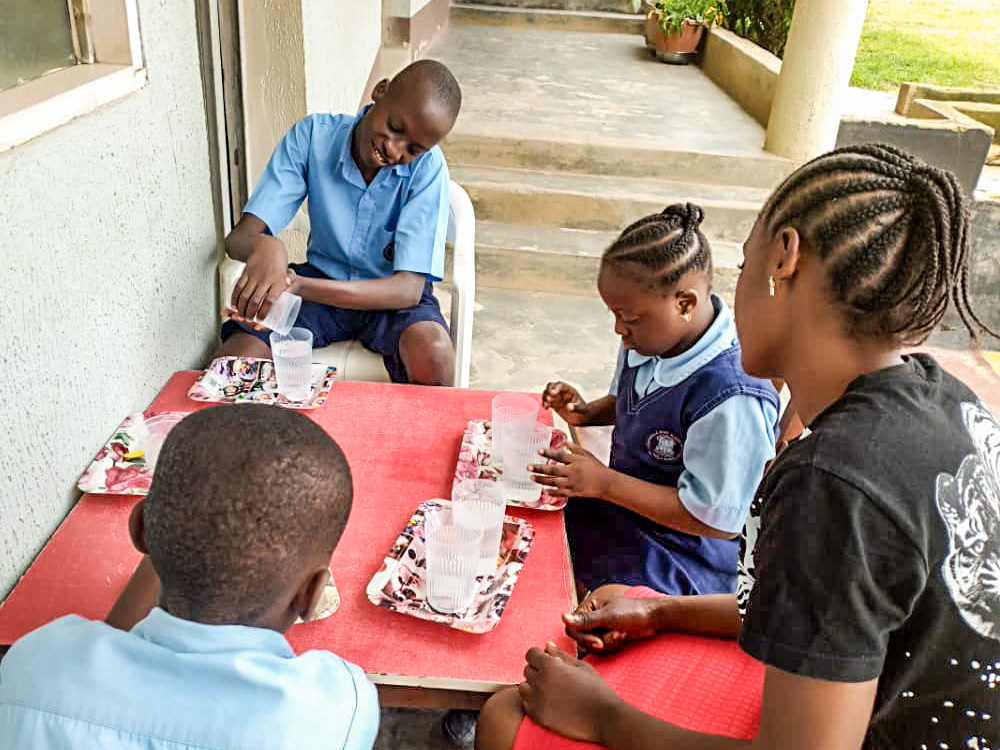
Students learn to pour water at the Community Based Rehabilitation Center in Akure, Ondo state, Nigeria. (Courtesy of Christie Udebor)
I reported my interactions and learnings with Mark and the other students to the head teacher of the school and to Mark's parents. I also shared an urgency I felt to commence his assessment process so that he could receive more help than I could give. There were challenges that I observed but did not know how to approach. I was just learning about the potentials of more diverse group learning.
At the workshop in Abuja, I learned about the need for a specialized team to assess students with disabilities and also their learning environment. Assessment teams include a psychologist, a speech-language pathologist, an occupational therapist, and a behavioral therapist. Assessment would also include standardized tests, observations in the classroom and interviews with the pupil and her/his family.
From those results the foundation for an individualized education plan would evolve, identifying the pupil's strengths and areas of need. Supports and services would then be provided to the student to help them succeed.
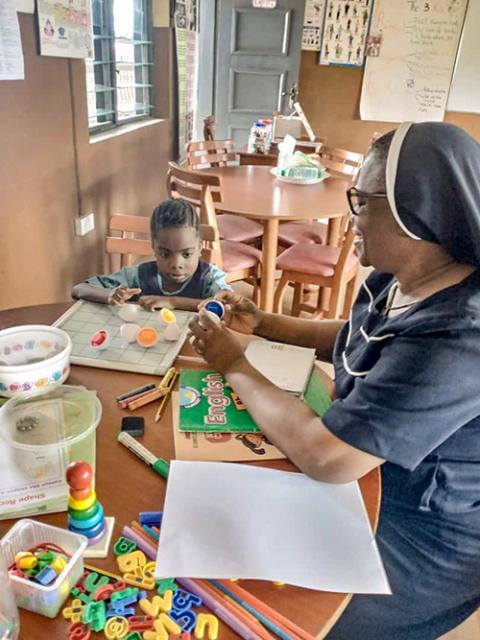
St. Louis Sr. Christie Udebor helps a student in a color-matching exercise at the Community Based Rehabilitation Center in Akure, Ondo state, Nigeria. (Courtesy of Christie Udebor)
A third step would be to have the pupil assigned to a special education teacher who, at the end of the school year, would meet with all members of the individualized education plan team, including the parents, child, specialists and school staff. At this conference, the team would review the student's progress and make any necessary changes to the plan for the next school year.
As I listened, my desire for training was great, but I also realized that inclusive education could put stress on budgets because it requires additional resources and funding. This is difficult for some of our schools to obtain, especially in areas with limited resources.
The benefits of inclusive education can be best sustained and supported through funding agencies, so that schools have the resources they need to provide quality education for all pupils. Professional development for teachers is also needed so that they have the skills and knowledge to work effectively with all pupils of diverse abilities. And finally, there needs to be a strong commitment from school leaders and policymakers to make inclusive education a priority.
It is also important to educate the community about the positive ripple effect of inclusive education. Having pupils with disabilities included and participating in the community helps break down barriers and stereotypes.
We must all do our part to ensure that all children have access to a quality education and feel accepted and included as valuable members of the community. I am so eager to be part of this new movement.
